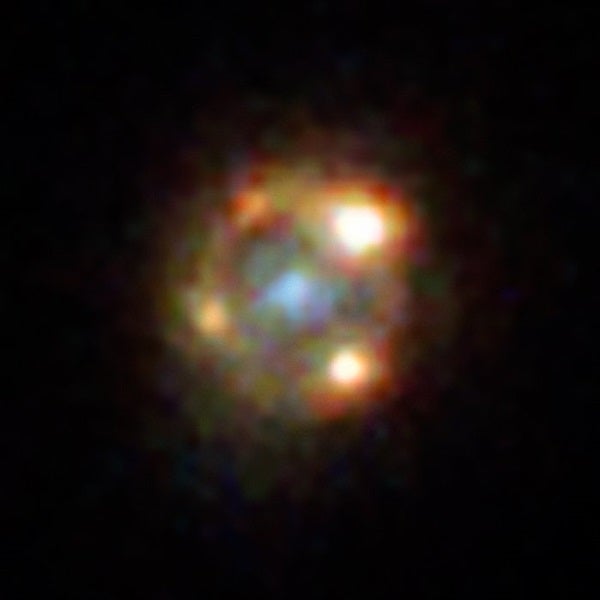Gravitational lensing is a phenomenon that bends and magnifies light from distant objects, allowing astronomers to essentially see behind objects in the nearby universe. The effect occurs when a massive object — usually a galaxy or a galaxy cluster — sits between a more distant object and Earth. As the light travels from the object toward Earth, it curves around the massive object in the way, thanks to the effects of general relativity. Now, astronomers have serendipitously observed this effect as it highlights a distant type Ia supernova, one of the best indicators for cosmic distance.
In a Science paper published April 21, lead author Ariel Goobar of the Oskar Klein Centre at the University of Stockholm, Sweden, and his colleagues report an amazing find: a quadruply-imaged and magnified type Ia supernova, called iPTF16geu. Although many objects have been observed via gravitational lensing before, iPTF16geu is the first — of hopefully many — type Ia supernova seen in such a way.
Type Ia supernovae occur when a white dwarf (a stellar remnant left behind by Sun-like stars) accumulates matter above a certain point, causing it to tear itself apart in a massive explosion. Because the tipping point is always the same mass — about 1.4 times the mass of the Sun, the explosion is always the same brightness. Thus, these explosions can be used as a “standard candle” of known brightness, and any dimming observed can be attributed to the object’s distance.
A rare event
When iPTF16geu was first spotted by the intermediate Palomar Transient Factory (iPTF) survey, astronomers immediately took notice. “I was baffled when I saw the initial data for iPTF16geu from the Palomar Observatory. It looked like a normal Type Ia supernova but it was much brighter than it should have been given its distance from us,” said Mansi Kasliwal of Caltech, a coauthor on the paper, in a press release announcing the find.
Through the Global Relay of Observatories Watching Transients Happen (GROWTH) project, which manages both instruments and staff around the world capable of following up on such finds, more data on iPTF16geu was quickly gathered. “The rapid follow up with more powerful facilities confirmed that we had stumbled upon an extremely interesting and rare event,” said Kasliwal.
Not only is iPTF16geu unique, but the object lensing it is strange as well. Based on the observations of iPTF16geu’s light researchers estimate that the intervening galaxy has a mass of 10 billion Suns in a radius spanning just 3,000 light-years. That’s unusually small for a typical lensing object, and could shed further light on the characteristics of objects capable of lensing light.
A valuable find
“Resolving, for the first time, multiple images of a strongly lensed ‘standard candle’ supernova is a major breakthrough,” said Goodbar. “Normally, when we view a lensed object, we don’t know the intrinsic brightness of that object, but with Type Ia supernova, we do. This will allow us to better quantify and understand the phenomenon of gravitational lensing.”
Gravitationally lensed objects provide a powerful probe into both the general theory of relativity and the expansion of the universe. The way that light curves around intervening matter as it travels allows for ever-more-precise checks of Einstein’s theories, as well as a deeper understanding of their implications for our universe. When light is separated into multiple images, as is the case with iPTF16geu, any delay in the arrival of subsequent images at Earth can be related to the expansion rate of the universe, allowing for precise measurement of the Hubble constant, which may change between the local and distant universe.
Ideally, the detection of many more lensed Type Ia supernovae will further increase astronomers’ ability to understand these characteristics of our cosmos.
Because lensed objects are magnified, they are easier to spot for follow-up on smaller telescopes. This is especially beneficial because time on the world’s biggest and most powerful telescopes is valuable and hard to come by. Furthermore, smaller telescopes can scan the sky much more quickly, allowing surveys to cover more celestial ground and find more objects such as lensed supernovae.
The iPTF project that discovered iPTF16geu was capable of covering 1/15th of the sky each night. This summer, the Zwicky Transient Facility (ZTF) will follow in its footsteps, scanning the entire accessible sky in a single night. And the Large Synoptic Survey Telescope, set to begin science operations in 2022, will cover the sky 10 times faster than the ZTF.
With more sky covered will come more transient and scientifically valuable objects, offering astronomers a growing library of objects with which to test our understanding of the universe.










